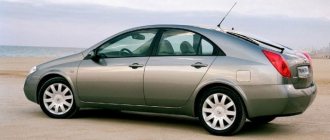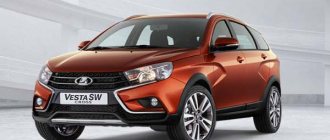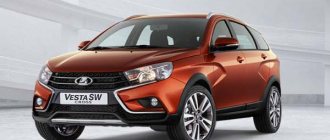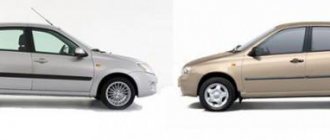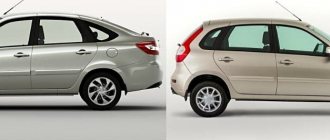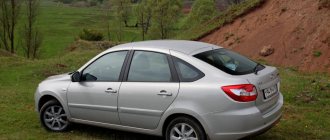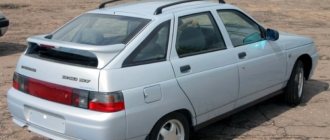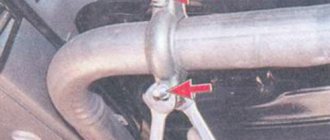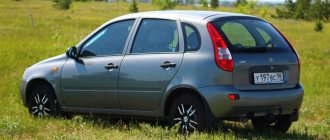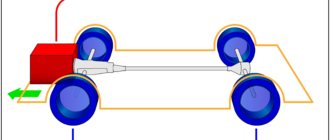Liftback
A liftback is a type of closed car body that is intermediate between a sedan, station wagon and hatchback. It differs from the hatchback in the longer rear overhang: the liftback has the same length as the sedan. The rear part of the roof can be either sloping or (less often) stepped, reminiscent of a sedan.
Body type Liftback
SUV
An SUV or SUV - Sport Utility Vehicle - is a type of vehicle with increased cross-country ability and increased ground clearance. The SUV (jeep) is distinguished by its impressive dimensions, all-wheel drive and reduction gear. Essentially, an SUV is a station wagon suitable for off-road use. Often an SUV has a frame body.
Separately, we can distinguish crossovers , or “SUVs” - this is how cars are often called whose driving properties do not allow them to be classified as “real” SUVs. The crossover combines the properties of a jeep and a station wagon (hatchback); it is more modest in size compared to an SUV, and its ground clearance is lower. Recently, the popularity of crossovers has been growing rapidly.
Volkswagen Tiguan
The most popular body types
This is one of the most popular designs in the 20th century. The body has 2-4 doors, inside the cabin there are seats for 4-5 passengers and the driver. Outside the cabin, in separate compartments, there is luggage and the car's engine.
Reference. In different countries this type is called differently. In England - Saloon, among the German population the name Limousine is popular, and in France - Berline.
This type is the successor to the station wagon and is quite popular among buyers. It combines comfort for passengers and the convenience of transporting small loads. The latter is achieved by folding a row of passenger seats.
This type was popular in the bygone 20th century. There are two rows of seats inside, and there is a fifth door at the back. The luggage compartment and passenger compartment are a single unit.
This body, depending on the car model, can have two or three volumes. It is characterized by a rear overhang, similar to a sedan, and a sloping roof, like a hatchback.
This option is also a favorite among car owners. It is a design with two doors and seats arranged in one row. In rare cases, additional seats will be installed in the rear. They are designed more for transporting children or accommodating pets.
Reference. The demands of modern times dictate their own rules, and coupes with a full-size second row of seats have begun to appear on the market. This includes high-end sports cars and small cars for urban use.
Expensive sports cars are created on the basis of this body. A distinctive feature is the absence of a hard roof; it is replaced by a folding awning against bad weather.
This variant is a relative of the convertible. Unlike its predecessor, it has only one row of seats, designed for two people. The roof has also been replaced with a folding fabric structure.
The limousine is designed for luxury cars; it has all the conditions for the convenience and comfort of passengers. This type is characterized by a spacious interior and a partition between the driver and passenger seats.
SUV
Another popular name among car enthusiasts is jeep. The characteristic features of this type are its large size, five or six doors, and two volumes are visually defined. Inside the cabin there are two or three rows of passenger seats. An SUV is most similar to a station wagon. The frame and body of the car do not interact with each other; the body belongs to the unloaded class.
In another way, this body type is called a “SUV”. Unlike an SUV, the body is monocoque, consisting of two volumes. Dimensions and ground clearance differ from an SUV to a smaller extent.
This type is most popular among North Americans. It has a large load capacity thanks to the open platform at the rear. The cabin has one row of seats and two doors.
This is a variant of a cargo-passenger vehicle. There are several modifications:
- station wagon based;
- based on a cargo chassis, complemented by a passenger cabin and an awning;
- based on a pickup truck.
A common feature of all vans is that the design consists of passenger seats and a metal cargo part at the rear of the vehicle.
This type is an intermediate stage between a station wagon and a minibus. Another name (rarely used) is a high-capacity station wagon. It is a one- or two-volume body with a half-hood design. It can have both two and three rows of seats in the cabin.
Three-volume units
The three-volume body has a protruding hood and trunk. Three-volume vehicles are among the least versatile bodies due to the limited possibility of transforming the interior and trunk. This group includes sedans, coupes, convertibles and pickups.
Sedan, coupe.
The most striking representative of the three-volume body is the sedan, which is present in the model range of almost all manufacturers.
Translated from Latin, “sedan” means “trough,” and indeed, the shape of this body resembles an inverted trough. By the way, this interpretation perfectly characterizes the domestic “classics” produced in the sedan body. But nevertheless, the sedan is considered the most conservative (classic) and prestigious body type.
The main difference between a coupe and a sedan is the two-door body. A coupe (from the French “couper” - to cut off) is usually built on the basis of a sedan and has a sporty bias (lower body, powerful engines). A coupe does not always have a pronounced three-volume body and is often shaped like a three-door hatchback. But a hatchback is always distinguished by its vertically positioned tailgate, which in a coupe they try to make as horizontal as possible.
Convertible, coupe-cabriolet, roadster.
Jaguar XK Convertible
A convertible is a coupe with a “soft” tent roof that folds behind the rear seats and rises if necessary.
Peugeot 207 CC coupe-convertible
But the soft top did not allow the car to be used all year round, so in the late 90s a new version of the open body began to gain popularity - the coupe-convertible. At first glance, it looks like a regular coupe, but when you press the right button, the hard metal roof lifts up and neatly folds into the trunk, turning the coupe into a convertible.
A two-seater convertible (without a second row of seats) is called a roadster.
Porsche Boxster Roadster Audi TTS Roadster
Pickup.
Mitsubishi L200 pickup
A pickup truck is a body with an open cargo area separated from the interior by a rigid partition. Simply put, it is a smaller copy of a regular truck. Most often this body is confused with a van. In order not to be mistaken, it is enough to remember that Pick-up in English also means “to pick up”, “to pick up”, that is, to quickly throw it into the back. Most pickup trucks are built on the same platform as SUVs and have good cross-country ability. Both here and throughout Europe, pickup trucks are not particularly popular, but in the USA they are crazy about them.
Station wagon: I take everything I own with me!
The station wagon is a five-door passenger car based on a sedan of the same model, in which 4 doors are located on the sides in pairs, and one in the rear of the body. The latter is located vertically and is the lid of the luggage compartment, which communicates with the interior of the car.
What does a station wagon look like?
If necessary, the luggage compartment volume can be increased by folding the rear row of seats (the same as in the hatchback we discussed above).
Of all types of passenger cars, station wagons are best suited for cargo transportation, which is why they have been consistently popular for many years among people working with large luggage.
The disadvantages of the class, as a rule, include increased injuries among passengers as a result of an accident. In the event of a collision, cargo from the trunk may fly into the cabin. In some countries, traffic regulations require the use of a special dividing grid that protects people from force majeure situations.
The main differences between a hatchback and a station wagon
Common features inherent in the hatchback and station wagon - both classes are a modified sedan with an essentially combined interior and trunk.
The differences between a hatchback and a station wagon are as follows:
- The size of the luggage compartment is significantly smaller in the Hatchback. The station wagon is excellent for cargo transportation and is often purchased by private entrepreneurs and medium-sized companies precisely for these purposes;
- The hatchback features a more elegant rear design. The inclined door looks much more beautiful than the strict vertical overhang of the station wagon. Women often make choices based on this;
- The station wagon is longer than the hatchback. This can be a significant drawback in urban environments if the car is used only for transporting passengers, but when it comes to large cargo, this is definitely an advantage;
- The hatchback can be supplied in a “sporty” 3-door configuration;
- Station wagons, as a rule, are more expensive than hatchbacks of the same series.
Both classes of passenger cars discussed in this article occupy their niche in the domestic market and are in demand among Russian motorists due to their features.
One of the most important criteria that guides the selection of a car is the body type. The number of car body types has almost doubled over the past 15-20 years. Manufacturers are increasingly trying to combine several body types in one car. It is becoming increasingly difficult to distinguish one option from another, but we will still do it.
Let's look at the classification of car body types
To begin with, we will divide all body types into 3 groups: three-volume, two-volume and single-volume.
Hatchback: an urban compromise
A hatchback is a variation of a passenger car with a short overhang, a rear “hatch” door and a small luggage compartment combined with the interior. Depending on the specific configuration, the car may have 1 (less often) or 2 rows of seats, 3 or 5 doors. The luggage compartment can be significantly increased by simply folding the rear seats.
What does a hatchback look like?
The appearance of hatchbacks was the result of the growing demand for a city car, behind the wheel of which the driver would feel comfortable in dense city traffic during rush hour. The border of the body runs along the edge of the rear wheels. The layout in most cases involves front-wheel drive with a transversely mounted engine. These solutions can significantly increase the vehicle’s maneuverability and make parking possible in difficult conditions.
A beginner who has just graduated from driving school will feel more confident in a hatchback, since the dimensions of the body are much better felt on it.
Let us once again pay attention to the characteristic distinctive features:
- Shortened rear overhang - thanks to this feature, the hatchback can be easily distinguished from other modifications in appearance;
- The trunk volume is less spacious than in station wagons or other variations;
- There is a door in the back wall. In some cases, the glass in it can open separately.
Due to the fact that the interior is actually combined with trunks, passengers may complain about an unpleasant odor emanating from the trunk if specific foods, motor oils, etc. are regularly transported there.
Minivan
The main difference between the minivan is the presence of a third row of seats, as well as its impressive length. Minivans are often equipped with sliding doors. Minivans are designed to carry passengers. The minivan seats seven people. Minivans based on vans received a separate name - minibuses . They accommodate up to 16 people.
Volkswagen Touran
Classification of passenger car bodies
Car bodies differ in functionality and technical characteristics. First of all, the types are divided according to the perception of loads, there are:
- carriers. In this case, there is no frame; the body carries the entire load. Most modern passenger cars belong to this type;
- semi-supporting. There is a rigid connection between the body and the frame. This type is used extremely rarely on passenger cars;
- unloaded. There is no contact with the frame; rubber gaskets or cushions are installed between it and the body.
Depending on the design:
- framed. The entire load rests on a rigid base on which individual cladding elements are fixed;
- semi-frame, another name for skeletal. Consists of separate parts (arcs, amplifiers, etc.), interconnected by cladding elements;
- frameless, consisting entirely of shells. These are stamped parts connected to each other into a single structure. Rigidity is imparted by the sections and shapes of individual elements. This is the most popular type, justified by ease of production and ease.
Another classification of bodies is determined by the presence of visual volumes. Their number can be found out by looking at the car from the side. Exist:
- single-volume. The side view is a single, almost convex figure;
- one and a half volume. Two visually distinguishable figures are identified. A representative of this type is a hatchback;
- two-volume. In this case, there are three figures - hood, interior, trunk. A striking example is the station wagon;
- three-volume. These are regular sedans and some liftbacks. There are clearly distinguishable boundaries of the hood, interior and trunk.
Sedans and Coupes
In principle, previously it was not difficult to distinguish a sedan from a coupe. The principle was simple. If a car has four doors, then the body is called a sedan. If a car has only two doors, then it is a coupe.
Today, the concept of coupe cars has expanded significantly due to the appearance on the market of four-door coupe cars.
Two-door sedans also appeared on the market.
How not to get confused in this multifaceted automobile market? How to determine which car is in front of you?
To quickly understand which coupe or sedan is in front of you, you should pay attention to the side supporting pillars of the car body. Let us denote them by the Latin letters “A”, “B” and “C”.
An "A" pillar on each side supports the windshield.
The "C" pillar holds the rear window.
The “B” pillar, as a rule, is only found in sedan cars. This structural body post provides structural support for the vehicle's roof and provides strong additional support for the vehicle's underbody.
The "B" pillar is located on the sides of each side of the vehicle. In addition, the “B” pillar provides the sedan doors with a fulcrum.
Cars in a coupe body, as a rule, do not have central “B” pillars, which in a sedan are an additional support for the doors.
Also, unlike sedans, often in coupe cars the front seats are located closer to the rear axle of the car.
How to identify two-door sedans? Very simple. Along the same supporting body pillars “A”, “B” and “C”.
For example, modern models such as the Honda Accord Coupe, Honda Civic Coupe, BMW 4 Series and Mercedes Benz C-Class Coupe have all three pillars on each side of the car body. As a result, all these cars have a sedan body, despite the fact that they only have two doors. So, despite having two-door bodies, these cars are not coupes.
But, for example, cars such as the Mercedes Benz AMG GT-S, Jaguar F-Type and Audi R8. These cars do not have a supporting pillar “B” on the side of the body (in the center). Also in these cars, the position of the seats in the cabin is located closer to the rear wheels.
Compact van
At its core, it is an ordinary minivan, but created on the platform of a compact car. Japanese automakers use the abbreviation MPV for this. In new versions you can find five and six-seater compact van body styles.
The microvan body belongs to the class of vans. Common in Japan, in demand as a commercial vehicle. Depending on the purpose, it has from 2 to 9 passenger seats. It must be equipped with two front doors, then two sliding doors and a door on the rear wall of the body.
Selecting a car body
It is necessary to choose a suitable body for the future car based on the needs and areas of application. For different types of drivers and situations, the following options can be recommended:
- novice driver. In the absence of experience, it will be irrational to purchase a large car. The best option is a small hatchback, sedan or station wagon;
- car for a girl or woman. In this case, the choice depends on ease of control (class A, B or C hatchback), or safety and cross-country ability (crossover);
- for a young guy. A crossover, SUV, large sedan or hatchback looks the most stylish and advantageous. Large and powerful cars are considered suitable for men;
- for a large family. The choice is determined by capacity and a large number of passenger seats. It can be a station wagon, minivan, crossover with an additional row of seats;
- for transportation of goods. If transportation is a rare occurrence, then large items will fit quite well in the cabin of an SUV or crossover. For regular use, a pickup truck or van is best;
- for traveling. As a rule, a large number of necessary things and items are taken into it. For these purposes, a roomy minivan, van, crossover, SUV or pickup is best suited;
- for frequent everyday use. Fans of active driving will choose a hatchback, sedan or crossover with high engine power. Buyers who prioritize safety will choose a crossover, SUV or minivan.
The shape of a car today is a complex combination of design, materials, technology, as well as fashion and product cost. Technologies move forward and force the body to change, new technological techniques appear, fashion and the understanding of prestige change. In this variety of forms, every car enthusiast can easily choose a model that meets all his needs.
